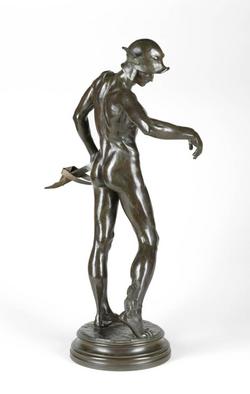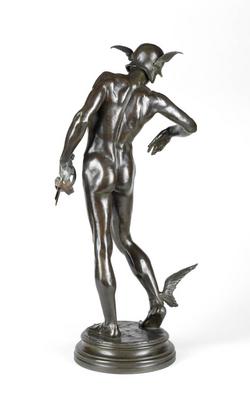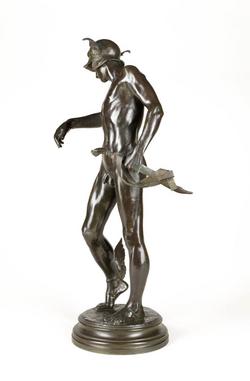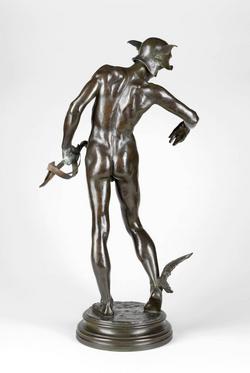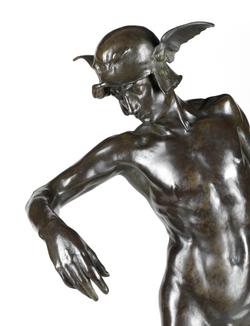Current Location: In storage
Titles
Perseus Arming
Maker(s)
Sculptor:
Gilbert, Alfred
Entities
Categories
Description
Nude figure of Perseus in the act of arming himself for future combat
Legal notes
Sir Ivor and Lady Batchelor Bequest through The Art Fund
Acquisition and important dates
Method of acquisition: Bequeathed
(2015-04-27)
by
Batchelor, Ivor, Sir and Lady
Dating
19th Century
Production date:
after
AD 1883
: Original plaster model: 1880-1; first bronze cast by 1882. This bronze version cast at an unknown date after 1883
Note
In Greek mythology, Perseus was son of Zeus (king of the gods) and the mortal Danaë. His greatest feat was to slay Medusa, the snake-haired Gorgon monster. It was as a mighty athletic victor, holding aloft Medusa’s severed head, that Benvenuto Cellini (1500-71) famously portrayed him in the 1550s. Gilbert spent several years in Italy studying Renaissance art, and Perseus Arming is his deeply personal, autobiographical response to Cellini’s prototype. Gilbert said:
'amazed as I was by that great work, it still left me somewhat cold, insomuch that it failed to touch my sympathies. As at that time my whole thoughts were of my artistic equipment for the future, I conceived the idea that Perseus before becoming a hero was a mere mortal, and that he had to look to his equipment. That is a presage of my life and work at that time.' (Hatton 1903, p. 10). By showing Perseus in the act of quietly equipping himself for future trials, Gilbert emphasised Perseus’ mortal rather than heroic character. Gilbert modelled the original plaster of Perseus Arming in Rome in 1880-1, and had the first bronze of it cast in Italy using the lost-wax casting method. This was exhibited at the Grosvenor Gallery, Bond Street, London in 1882 to great acclaim (his marble Kiss of Victory was exhibited at the Royal Academy at the same time) and at the Paris Salon in 1883, where it received an honourable mention.
Perseus Arming was a highly significant early work and the first of three important, deeply personal bronzes which Gilbert made during his highly creative period of 1881 to 1892 (the other two being Icarus and Comedy and Tragedy - for a cast of the latter, see M.1-2003). Perseus Arming was one of Gilbert's most popular models. It was reproduced in three sizes: full-scale (c.71-74 cm), which is rare; half-scale (c.36 cm), the most popular size of which the Fitzwilliam has a fine version (M.4-1951); and quarter-scale (c.14.5cm). The dimensions of the present bronze are unusual; it may have been owned by Queen Victoria’s grandson, Alexander Mountbatten, 1st Marquess of Carisbrooke (1886–1960).
Sir Alfred Gilbert RA MVO (1854-1934) was an English sculptor. He studied in London, Paris and Rome, returning to England in 1884. Gilbert was the leading artist in the New Sculpture movement, which revitalised sculpture in late nineteenth-century Britain. He was also a vital force in reintroducing the lost-wax technique for casting works of art in bronze in England (sand-casting had been the norm for bronze sculpture since the 18th century, with lost-wax casting used only for small-scale work and jewellery). His commissions included the jubilee memorial to Queen Victoria in Winchester and the statue of Eros, in aluminium, for the Shaftesbury Memorial Fountain in Piccadilly Circus, and in 1900 he was appointed Professor of Sculpture at the Royal Academy. A period of bankruptcy and divorce followed, and Gilbert moved to Bruges. On his return to England in 1926, his fortunes improved, the highlight being the bronze Queen Alexandra Memorial, at Marlborough House, London, 1926-32. He was knighted by George V in 1932. Gilbert died in poverty in 1934.
School or Style
New Sculpture Movement
Components of the work
Base
Height 5.7 cm
Length 22.5 cm
Width 22.5 cm
Figure
Height 67.9 cm
Length 26.9 cm
Width 39.5 cm
Materials used in production
Copper alloy
Bronze
Techniques used in production
Casting (process)
: Bronze, cast, patinated
Patination
References and bibliographic entries
Related exhibitions
Identification numbers
Accession number: M.22-2015
Primary reference Number: 201931
Old object number: 18
Stable URI
Audit data
Created: Thursday 25 June 2015
Updated: Monday 29 April 2024
Last processed: Tuesday 29 July 2025
Associated departments & institutions
Owner or interested party:
The Fitzwilliam Museum
Associated department:
Applied Arts
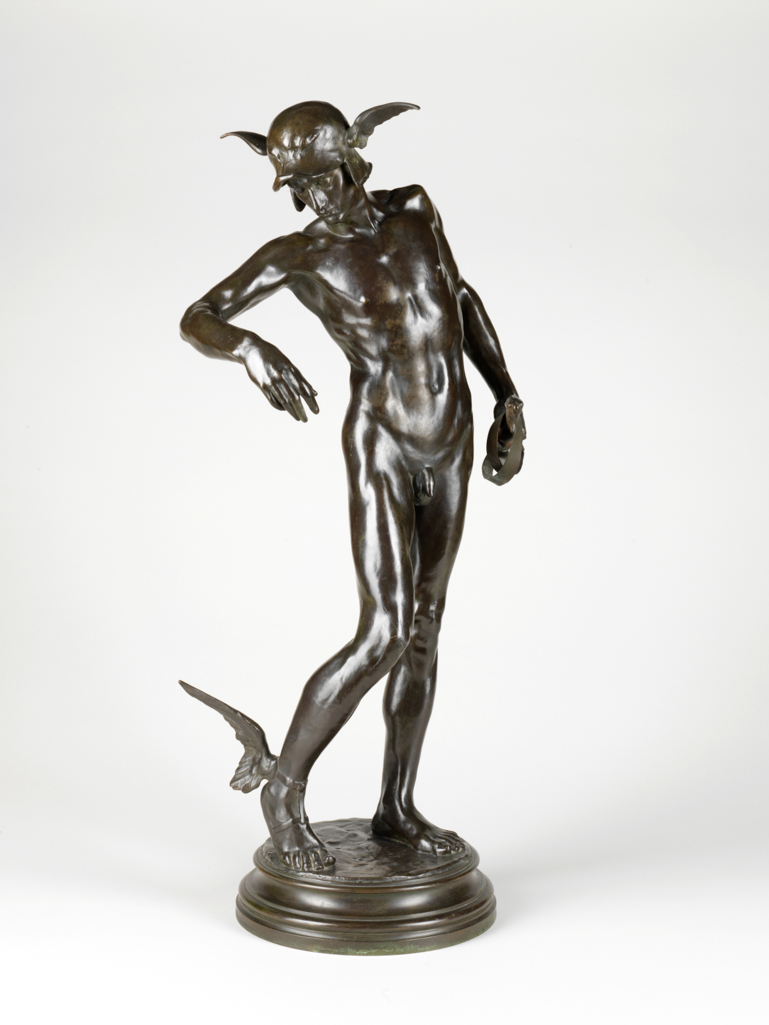
 IIIF Manifest
IIIF Manifest
